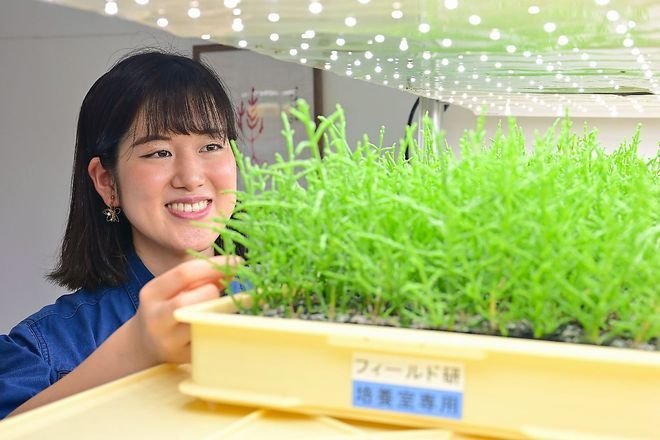[ad_1]
The common glasswort, an edible succulent plant, could be manna from heaven to farmers struggling in regions impacted by salt-ravaged agricultural fields.
Researchers at Meiji University in Tokyo have increased the yield of the plant, which is also called salicornia europaea, that can thrive in such a difficult environment.
Through a new method developed by the research team, glasswort can be easily cultivated through grafting by cutting the plant.
The method, which is simple and efficient, offers hope for the mass cultivation of the salt marsh plant, since farmers in developing countries can readily adopt it.
According to an international study, brine damage to agricultural products cost 500 million euros (79.5 billion yen) globally.
Glasswort, also called sea asparagus, is sold as a vegetable in Europe.
But in Japan, where colonies of the species exist in Hokkaido and Okayama Prefecture, it is designated an endangered species requiring protection by the Environment Ministry.
Glasswort flourish in saline environments in the Northern Hemisphere, such as in tidal flats and marshes with brackish water.
Studies in recent years show the plant may also be used for applications such as removing salt from farmland and in materials ranging from biofuels to drugs slowing the aging process and fighting cancer.
But the biggest barrier to mass production is that germinating the plant is a delicate and complex process.
In addition, glasswort grows unevenly.
However, Kaoruko Koshida, a graduate student, Yoshikazu Ito, a lecturer of protected horticulture, and Koji Kawagishi, a project specific professor of horticulture, have developed a new way of propagating the species and managing its growth.
In an experiment, they selected plants of 7-10 centimeters in length and 2-3 millimeters in diameter and cut into a section 6 cm from the growth points.
Then, the cuttings were soaked in a mixture of sodium chloride and nutrient culture solution on trays.
Roots began to grow from the trimmings when they were put in a temperature-controlled, lit room.
When given an optimal concentration of saltwater and nutrient culture solution, more than 90 percent of the cuttings sprouted roots in about 12 days.
The results show that the cutting method is simpler and more efficient for propagating the plant over a short period, compared with the conventional method.
The team’s findings point to the possibility of selective breeding and ensuring a stable supply to the market in the future.
Toru Maruo, chairman of the Institute for Horticultural Plant Breeding and professor emeritus of horticulture at Chiba University, noted that propagating glasswort is a research topic that has not been deeply explored.
“The new method may contribute greatly to people in the developing world since it is easier to mass-produce the plant and expand it to a local industry,” he said.
Koshida received inspiration for the novel way about five years ago, when she was a first-year agriculture major at the university.
When she took an English class, she had to give a presentation before students on the subject of “living creatures that can survive in a harsh environment.”
She thought of a species enduring salt damage.
Her search for such an existence led to glasswort, which has a high level of sodium tolerance.
As she looked into recent studies of the plant, she was intrigued by the wide nutritional value it contains and its potential for commercial applications.
“This could prove to be a savior of the world,” she recalled thinking.
But she also learned about the difficulty of raising the species.
For one, salt concentration levels suitable to their growth changes, depending on the stage of their lifespan.
In Hokkaido, glasswort seeds in marshes near the sea germinate after being exposed to seawater whose salt concentration level is extremely low, similar to that of freshwater, after melted snow water flows in the area.
Seeds use salt accumulated inside to absorb water through osmosis and thereafter grow on their exposure to salt water coming from rising and falling tides.
But it appeared an enormous challenge to artificially re-create such a condition and also on a large scale, given the delicate nature of the species’ harsh habitat.
Koshida hit upon the idea for planting a cutting of glasswort and sought to experiment with it.
The team’s approach was apparently unprecedented.
“Our search for academic papers on raising glasswort from a cutting found no results,” said Ito.
The problem was that glasswort is not commercially available in Japan due to its designation as a rare species.
No seeds of the plant were available at nursery stores.
But the researchers obtained a sample of the species imported from Israel, sold as a vegetable at a Costco store.
Their report, published in the online edition of the Journal of Horticultural Science and Biotechnology, a British scientific journal, on Sept. 13, is based on their experiment using the glasswort from Costco.
They later obtained glasswort seeds.
After receiving a permit from the Hokkaido government, the scientists took samples of glasswort, soil and water at six locations in Hokkaido in August 2023, succeeding in germinating the seeds to use them for a future study.
One of the sites is Notoroko, a seawater lake in eastern Hokkaido connected with the Sea of Okhotsk, a habitat for a large colony of the species.
“It would be nice if a visitor to Notoroko could enjoy a view of the glasswort first and dine on glasswort tempura at an inn near the lake,” Koshida said.
[ad_2]
Source link
Share this content:
